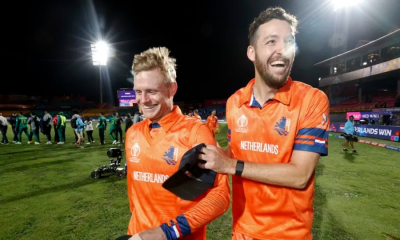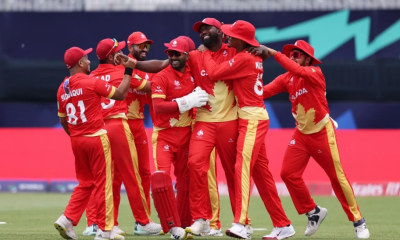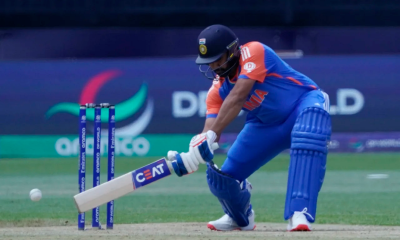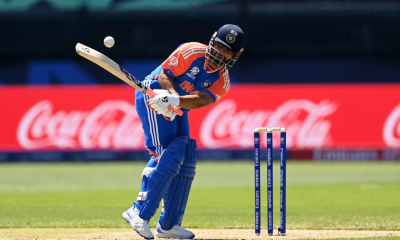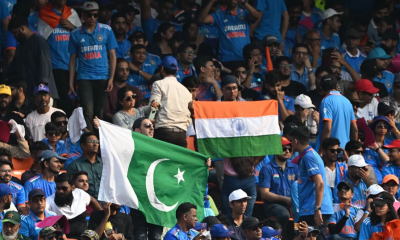Foreign News
Have Trump prosecutors made their case at hush-money trial?
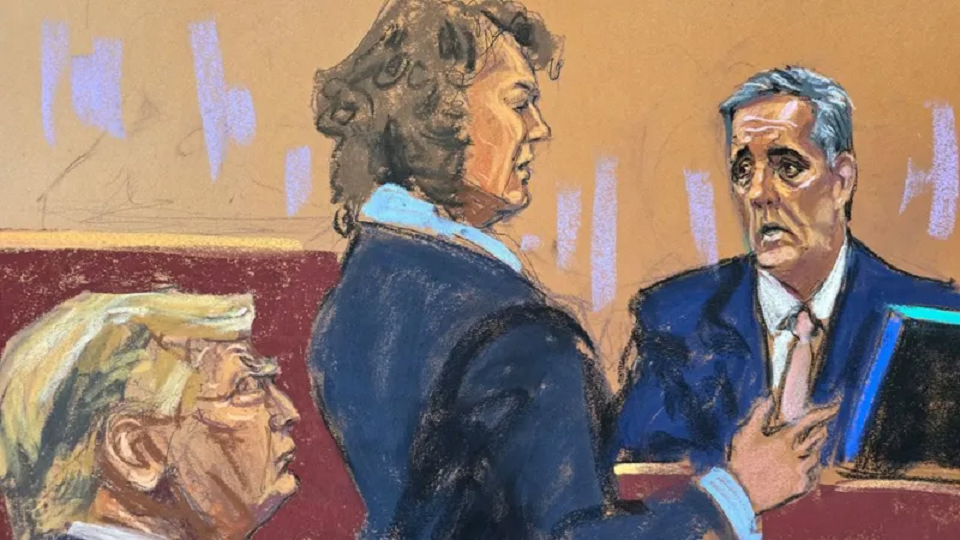
For nearly four weeks, Donald Trump has sat quietly in a New York courtroom while state prosecutors laid out the first-ever criminal case against a former US president.
Lawyers from the Manhattan District Attorney’s Office have called on a cast of blockbuster witnesses and produced dozens of surreptitiously recorded conversations and documents to help corroborate their case.
They allege Mr Trump directed a hush-money payment to an adult-film star in 2016 to avoid a sex scandal he feared would derail his presidential campaign – and then authorised an illegal reimbursement scheme to cover it up. Mr Trump denies 34 counts of falsifying business records.
The prosecution’s final witness, Michael Cohen, will face further cross-examination on Monday before Trump’s lawyers get an opportunity to present his defence.
Legal experts say the prosecution has done an efficient job. But even with solid evidence and testimony, they acknowledge that a conviction in the complex felony case is far from guaranteed.
“The pieces are all there. But is it there beyond a reasonable doubt?” said former Brooklyn prosecutor Julie Rendelman. “I don’t know.”
“It only takes one juror,” she added.
Laying out the story
Though Mr Trump’s case centres on a reimbursement he made to Cohen, his former fixer, prosecutors spent the first weeks of the trial walking the court through what led up to the $130,000 (£102,000) hush-money payment Cohen made to adult-film star Stormy Daniels.
They started with David Pecker, the former publisher of the National Enquirer.
He described a series of meetings in Trump Tower where he, Cohen and Mr Trump hatched a plan to suppress negative stories about Mr Trump – including alleged sexual encounters – as he ran for president.
His testimony proved influential, said former Manhattan prosecutor Lance Fletcher. “He doesn’t have a reputation that’s been blown apart by this. And he came into it really seeming to be Trump’s friend,” Mr Fletcher said. “So I think he comes off as almost an impartial witness.”
From there, prosecutors called a host of others, including former Trump aide Hope Hicks and Daniels’ former attorney Keith Davidson, to corroborate the story.
“They sort of connected a fascinating novel … about how all of these characters interacted,” said Columbia Law School professor John Coffee. “And that was wise.”
They also interspersed evidence such as meeting logs, recordings and receipts of hush-money payments made to a Trump Tower doorman and Playboy model Karen McDougal to bolster witnesses’ stories.
Star witnesses air secrets
Prosecutors used weeks of storytelling and evidence to build up to the most highly anticipated witnesses, including Ms Daniels.
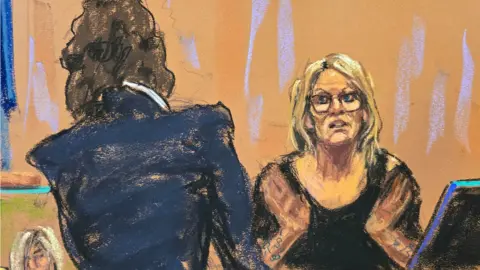
Mr Trump’s attorneys worked hard to limit Ms Daniels’ testimony.
While prosecutors pledged to tread lightly when quizzing her about the alleged sexual encounter at a hotel suite in Nevada in 2006, she still proved at times an uncontrollable witness, Judge Juan Merchan told the court. Mr Trump has denied having sex with her.
Her explicit testimony led to several unsuccessful mistrial motions from Mr Trump’s legal team and may have opened the door for an appeal, some legal experts said.
But others said that context helped prosecutors show why Mr Trump would be desperate to pay for her silence in order to protect his campaign.
“She got into some salacious details, which I thought went too far,” said Ms Rendelman. “But at the same time, the argument for the prosecution is the more salacious it is, the more Trump would want it to be shut down.”
Ultimately, Ms Daniels could only testify to what led up to the hush-money payment.
For the behind-the-scenes reimbursement, they had to rely on a problematic witness: a convicted felon who recently has made a living off attacking Mr Trump.
A calm and collected Cohen takes the stand
Members of the public held their breath earlier this week as Mr Trump’s former fixer-turned foe, Cohen, was called to the stand. Many anticipated the same character who authored fiery social media posts attacking Mr Trump, for whom he once pledged to take a bullet. But the man speaking in a blue suit and tie took them by surprise. Cohen appeared composed as he detailed his decades with Mr Trump.
“He is measured. He is reflective,” said Diane Kiesel, a former New York Supreme Court Justice and Manhattan prosecutor. “He has not let any bias or animus for Mr Trump show through.”
Cohen told the court of his initial admiration, working as Mr Trump’s personal attorney for 10 years. He acknowledged the lows as well, including lying on Mr Trump’s behalf, leading to regrets.
His composure boosted the prosecutors’ case, and his testimony was bolstered by a weak cross-examination from Mr Trump’s legal team on day one, experts said.
Mr Trump’s attorney, Todd Blanche, appeared disorganised at first, stumbling sometimes in his questioning, experts told the BBC.
But he appeared to make strides on the second day, Thursday, casting doubt on details of Cohen’s testimony, including an October 2016 phone call Cohen made to Mr Trump’s bodyguard in which he claimed to have to talked to Mr Trump about details of the hush-money payment.
It was a reminder of what experts said was one of prosecutors’ largest problems: Cohen’s credibility. The defence hammered home the point that Cohen is a convicted criminal, who spent time in prison after being convicted on several charges including lying to Congress.
Cohen was able to testify to a key part of prosecutors’ case – Mr Trump’s direct knowledge of the hush-money payment reimbursement scheme.
Cohen said former Trump Chief Financial Officer Allen Weisselberg – currently serving a perjury sentence at Rikers Island prison – decided to classify reimbursements from Mr Trump’s account as legal expenses. Cohen testified that he heard Weisselberg get the OK from Mr Trump himself.
As Cohen spoke, prosecutors also displayed the dozens of cheques, ledgers and invoices at the heart of the 34-count indictment.
But Cohen’s story may not sway all jurors.
“You are relying on a witness who in many respects … comes with a larger load of baggage than others,” Ms Rendelman said. “It makes it a bit more difficult to prove the case beyond a reasonable doubt.”
Connecting the dots
Other challenges remain for the prosecution.
In a relatively novel approach, the Manhattan District Attorney’s Office elevated falsifying business records charges to a felony by claiming Mr Trump did so with the goal of concealing another crime.
To prove their case, prosecutors must show intent – that Mr Trump illegally classified records for the purpose of aiding his campaign. Several witnesses seemed to corroborate this.
“He wasn’t thinking at all about [his wife] Melania,” Cohen told the court. “This was all about the campaign.”
But prosecutors must make this connection clear to the jury.
“Essentially they have to connect these payments to a motive that links them to a campaign,” said Ms Kiesel. “This requires a summation of a lifetime, because you really have to connect these dots.”
Mr Fletcher said prosecutors succeeded in doing so, with witnesses arguing the hush-money payment and reimbursement was not made to protect Mr Trump’s family.
“This was all about the election,” Mr Fletcher said. “If I was going to bet, I would bet on a conviction. But I don’t think it’s a slam dunk.”
In the end, the verdict could come down to jury selection, experts said.
The 12 members and six alternates were picked from hundreds who expressed a range of political views and familiarity with Mr Trump and this case.
Jury members are often unpredictable, Ms Kiesel said. “It only takes one person to decide that the people have not met their burden,” she said. “The people have 12 jurors to convince.”
(BBC)
Foreign News
Nasa ‘Earthrise’ astronaut dies at 90 in plane crash

Apollo 8 astronaut Bill Anders, who snapped one of the most famous photographs taken in outer space, has died at the age of 90.
Officials say a small plane he was flying crashed into the water north of Seattle, Washington.
Anders’ son Greg confirmed that his father was flying the small plane, and that his body was recovered on Friday afternoon. “The family is devastated. He was a great pilot. He will be missed,” a statement from the family reads.
Anders – who was a lunar module pilot on the Apollo 8 mission – took the iconic Earthrise photograph, one of the most memorable and inspirational images of Earth from space.
Taken on Christmas Eve during the 1968 mission, the first crewed space flight to leave Earth and reach the Moon, the picture shows the planet rising above the horizon from the barren lunar surface.
Anders later described it as his most significant contribution to the space programme.
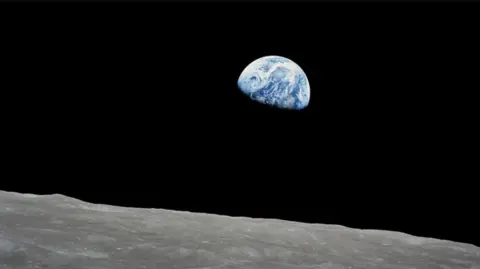
The image is widely credited with motivating the global environmental movement and leading to the creation of Earth Day, an annual event to promote activism and awareness of caring for the planet.
Speaking of the moment, Anders said: “We came all this way to explore the Moon, and the most important thing that we discovered was the Earth.”
Officials said on Friday that Anders crashed his plane around 11:40PDT (1940BST).
The US National Transportation Safety Board (NTSB) said the 90-year-old was flying a Beechcraft A A 45 – also known as a T-34. The agency said that the plane crashed about 80ft (25m) from the coast of Jones Island.
Anders also served as the backup pilot to the Apollo 11 mission, the name of the effort that led to the first Moon landing on July 24, 1969.
Following Anders’ retirement from the space programme in 1969, the former astronaut largely worked in the aerospace industry for several decades. He also served as US Ambassador to Norway for a year in the 1970s.
But he is best remembered for the Apollo 8 mission and the iconic photograph he took from space.
“In 1968, during Apollo 8, Bill Anders offered to humanity among the deepest of gifts an astronaut can give. He traveled to the threshold of the Moon and helped all of us see something else: ourselves,” Nasa Administrator Bill Nelson said in a statement.
Mark Kelly, a former astronaut who now serves as a US Senator for the state of Arizona, said in a post on X, formerly Twitter, that Anders “inspired me and generations of astronauts and explorers. My thoughts are with his family and friends”.
[BBC]
Foreign News
China’s Chang’e-6 lifts off from far side of Moon with rock samples

A Chinese spacecraft carrying rock and soil samples from the far side of the Moon has lifted off from the lunar surface to start its journey back to Earth, according to state media.
The achievement on Tuesday is a world first and the latest leap for Beijing’s decades-old space programme, which aims to send a crewed mission to the Moon by 2030.
The Xinhua News Agency, citing the China National Space Administration (CNSA), said that the ascender of the Chang’e-6 probe took off at 7:38am local time on Tuesday (23:38 GMT) and entered a preset orbit around the moon.
It described the move as “an unprecedented feat in human lunar exploration history”.
The Chang’e-6 probe was launched last month and its lander touched down on the far side of the Moon on Sunday. It used a drill and robotic arm to dig up soil on and below the Moon’s surface, according to Xinhua.
After successfully gathering its samples, the Chang’e-6 unfurled China’s national flag for the first time on the far side of the Moon, it said.
The agency cited the CNSA as saying that the spacecraft stowed the samples it had gathered in a container inside the ascender of the probe as planned.
[Aljazeera]
Foreign News
China says its spacecraft lands on Moon’s far side

China says its uncrewed craft has successfully landed on the far side of the Moon – an unexplored place almost no-one tries to go.
The Chang’e 6 touched down in the South Pole-Aitken Basin at 06:23 Beijing time on Sunday morning (22:23 GMT Saturday), the China National Space Administration (CNSA) said.
Launched on 3 May, the mission aims to collect precious rock and soil from this region for the first time in history. The probe could extract some of the Moon’s oldest rocks from a huge crater on its South Pole.
The landing was fraught with risks, because it is very difficult to communicate with spacecraft once they reach the far side of the Moon. China is the only country to have achieved the feat before, landing its Chang’e-4 in 2019.
After launching from Wenchang Space Launch Center, the Chang’e 6 spacecraft had been orbiting the Moon waiting to land. The lander component of the mission then separated from the orbiter to touch down on the side of the Moon that faces permanently away from Earth.
During the descent, an autonomous visual obstacle avoidance system was used to automatically detect obstacles, with a visible light camera selecting a comparatively safe landing area based on the brightness and darkness of the lunar surface, the CNSA was quoted as saying by state-run Xinhua news agency.
The lander hovered about 100m (328ft) above the safe landing area, and used a laser 3D scanner before a slow vertical descent. The operation was supported by the Queqiao-2 relay satellite, the CNSA said.
Chinese state media described the successful landing as an “historic moment”. The state broadcaster said “applause erupted at the Beijing Aerospace Flight Control Center” when the Chang’e landing craft touched down on the Moon early on Sunday morning.
The lander should spend up to three days gathering materials from the surface in an operation the CNSA said would involve “many engineering innovations, high risks and great difficulty”. “Everyone is very excited that we might get a look at these rocks no-one has ever seen before,” explains Professor John Pernet-Fisher, who specialises in lunar geology at the University of Manchester.
He has analysed other lunar rock brought back on the American Apollo mission and previous Chinese missions. But he says the chance to analyse rock from a completely different area of the Moon could answer fundamental questions about how planets form.
Most of the rocks collected so far are volcanic, similar to what we might find in Iceland or Hawaii. But the material on the far side would have a different chemistry . “It would help us answer those really big questions, like how are planets formed, why do crusts form, what is the origin of water in the solar system?” the professor says.
The mission aims to collect about 2kg (4.4lb) of material using a drill and mechanical arm, according to the CNSA.
The South Pole–Aitken basin, an impact crater, is one of the largest known in the solar system.
From there, the probe could gather material that came from deep inside the lunar mantle – the inner core of the Moon – Prof Pernet-Fisher says.
The Moon’s South Pole is the next frontier in lunar missions – countries are keen to understand the region because there is a good chance it has ice.
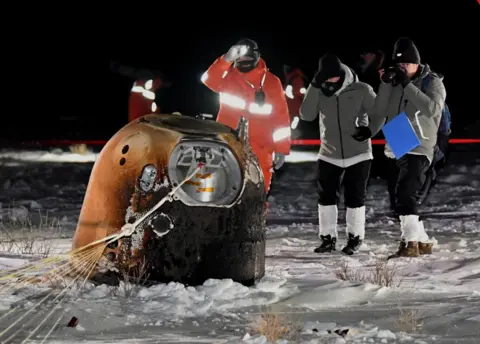
The capsule in the last Chinese moon mission, Chang’e 5, brought back soil and rocks in 2020 (BBC)
Access to water would significantly boost the chances of successfully establishing a human base on the Moon for scientific research.
If the mission succeeds, the craft will return to Earth with the precious samples on board a special return capsule.
The material will be kept in special conditions to try to keep it as pristine as possible.
Scientists in China will be given the first chance to analyse the rocks, and later researchers around the world will be able to apply for the opportunity too.
This is the second time China has launched a mission to collect samples from the Moon.
In 2020 Chang’e 5 brought back 1.7kg of material from an area called Oceanus Procellarum on the Moon’s near side.
China is planning three more uncrewed missions this decade as it looks for water on the Moon and investigates setting up a permanent base there.
Beijing’s broader strategy aims to see a Chinese astronaut walk on the moon by around 2030.
The US also aims to put astronauts back on the moon, with Nasa aiming to launch its Artemis 3 mission in 2026.
(BBC)


